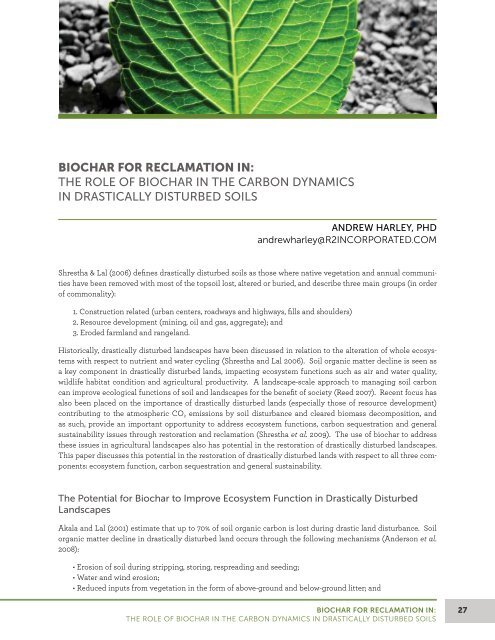U.S.-FocUSed Biochar report - BioEnergy Lists
U.S.-FocUSed Biochar report - BioEnergy Lists
U.S.-FocUSed Biochar report - BioEnergy Lists
You also want an ePaper? Increase the reach of your titles
YUMPU automatically turns print PDFs into web optimized ePapers that Google loves.
<strong>Biochar</strong> for reclamation in:The Role of <strong>Biochar</strong> in the Carbon Dynamicsin Drastically Disturbed Soilsandrew Harley, PhDandrewharley@R2INCORPORATED.COMShrestha & Lal (2006) defines drastically disturbed soils as those where native vegetation and annual communitieshave been removed with most of the topsoil lost, altered or buried, and describe three main groups (in orderof commonality):1. Construction related (urban centers, roadways and highways, fills and shoulders)2. Resource development (mining, oil and gas, aggregate); and3. Eroded farmland and rangeland.Historically, drastically disturbed landscapes have been discussed in relation to the alteration of whole ecosystemswith respect to nutrient and water cycling (Shrestha and Lal 2006). Soil organic matter decline is seen asa key component in drastically disturbed lands, impacting ecosystem functions such as air and water quality,wildlife habitat condition and agricultural productivity. A landscape-scale approach to managing soil carboncan improve ecological functions of soil and landscapes for the benefit of society (Reed 2007). Recent focus hasalso been placed on the importance of drastically disturbed lands (especially those of resource development)contributing to the atmospheric CO 2 emissions by soil disturbance and cleared biomass decomposition, andas such, provide an important opportunity to address ecosystem functions, carbon sequestration and generalsustainability issues through restoration and reclamation (Shrestha et al. 2009). The use of biochar to addressthese issues in agricultural landscapes also has potential in the restoration of drastically disturbed landscapes.This paper discusses this potential in the restoration of drastically disturbed lands with respect to all three components:ecosystem function, carbon sequestration and general sustainability.The Potential for <strong>Biochar</strong> to Improve Ecosystem Function in Drastically DisturbedLandscapesAkala and Lal (2001) estimate that up to 70% of soil organic carbon is lost during drastic land disturbance. Soilorganic matter decline in drastically disturbed land occurs through the following mechanisms (Anderson et al.2008):• Erosion of soil during stripping, storing, respreading and seeding;• Water and wind erosion;• Reduced inputs from vegetation in the form of above-ground and below-ground litter; and<strong>Biochar</strong> for reclamation in:The Role of <strong>Biochar</strong> in the Carbon Dynamics in Drastically Disturbed Soils27
















